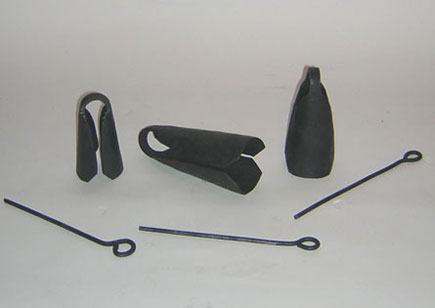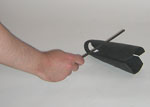
: : : Percussions : : Mandingo : Instruments
The Mandingo cowbells

Mandingo cowbells ("kenkens") are alike Cuban cowbells (they are also still used in Africa to locate livestock (cattle, goats, etc., Tied around their necks)), but they keep older characteristics. They are forged (hammered) and not welded (open along their length), and crude steel (not chromed or painted). They are fitted with a steel hook bent at the end, in order to tie them with a rope. Their sound is very crystalline especially if they are thick, and this characteristic is accentuated by the traditional hit by an iron rod as well (in fact the clapper removed from the bell: see photo which shows the loop that is used to attach the clapper to the bell). Each bell is associated with one of the three dununs according to its size, but generally doesn't play three different phrases, unlike dununs. In addition, these phrases always overlap at some moments, unlike those of dununs. A bit like the Brazilian "agogos" or Cuban "cowbells", they offer voluble and intertwined figures (with many double strokes).
The basic figure the most typical is another beguine than that of the djembes: Ti - titi - titi -
This pattern can be shifted or combined with single strokes (example: titi - titi - ti - or: ti - titi - titi - ti - ti - ti - ti - .).
 This is usually the left hand (unlike jazz) that plays the bell traditionally, and it does not improvise (like the cymbal of jazz drumming, and Latin timbale cowbell).
This is usually the left hand (unlike jazz) that plays the bell traditionally, and it does not improvise (like the cymbal of jazz drumming, and Latin timbale cowbell).
Note also that, unlike the (good) jazz or rock drummers, right hand (the one that hits the dunun) almost always plays systematically in unison with the bell, distinguishing from the latter by varying the strike or letting play it alone, which makes easier the problem of "independence" playing. Only dunun and bell virtuosos easily improvise with total independence of the right hand. The "cascara", Cuban cowbell pattern the most famous and typical is already played on kenken in an old Mandingo polyrhythm called "djagbé", which occurs at the end of Ramadan. The practice of "double drumming" (playing of the bass drum and cymbals by a single musician) in the nineteenth century in Louisiana (USA), is reminiscent of dununs and kenkens practice and even in the rhythms used.
Marc Douvan, October 2005, translation in English: May 2013.
© 2005 Marc de Douvan Crédits Mentions légales
